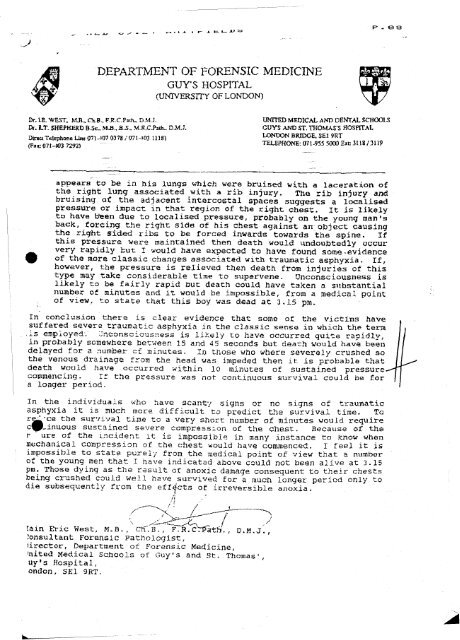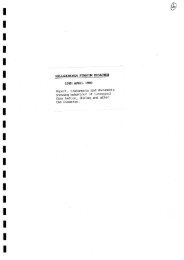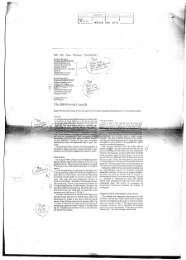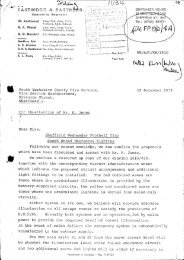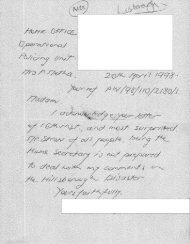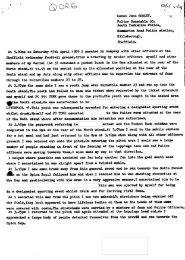DEPARTMENT OF FORENSIC MEDICINE - Hillsborough ...
DEPARTMENT OF FORENSIC MEDICINE - Hillsborough ...
DEPARTMENT OF FORENSIC MEDICINE - Hillsborough ...
You also want an ePaper? Increase the reach of your titles
YUMPU automatically turns print PDFs into web optimized ePapers that Google loves.
' W '<br />
»■« i i i. i r jl tz. I— -A-*<br />
<strong>DEPARTMENT</strong> <strong>OF</strong> <strong>FORENSIC</strong> <strong>MEDICINE</strong><br />
GUY'S HOSPITAL<br />
(UNIVERSITY <strong>OF</strong> LONDON)<br />
Dr. I.E. -WEST. MB.. FR.C.Pwix.. D.M.J.<br />
Dr. R.T. SHEPHERD B.Sc., M 3., J3.S, M-R.C.Piih-. D.M.J.<br />
Direct Telephone Line 071-107 03?g /071-103 1118)<br />
(Fa*: 071-J03 7292)<br />
P - 0 8<br />
UNITED MEDICAL AND DENTAL SCHOOL<br />
GUYS AND ST, THOMAS'S HOSPITAL<br />
LONDON BRIDGE, SE1 9RT<br />
TELEPHONE: 071 -955 5000 Ext: 3118 / 3119<br />
appears to be in his lungs which were bruised with a laceration of<br />
the right lung associated with a rib injury. The rib injury and<br />
bruising of the adjacent intercostal spaces suggests a localised<br />
pressure or impact, in that region of the right chest. It is likely<br />
to have Been due to localised pressure, probably on the young man’s<br />
back, forcing the right side of his chest against an object causing<br />
the right s i d e d ribs to be forced inwards towards the spine. If<br />
this pressure were maintained then death would undoubtedly occur<br />
very rapidly but I would have expected to have found sorae-evidence<br />
^ of the more classic changes associated with traumatic asphyxia. If,<br />
however, the pressure is relieved then death from injuries of this<br />
type may take considerable time to supervene. Unconsciousness is<br />
likely to be fairly rapid but death could have taken a substantial<br />
number of minutes and it would be impossible, from a medical point<br />
of view, to state that this boy was dead at 3,15 pm.<br />
In conclusion there is clear evidence that some of the victims have<br />
suffered severe traumatic asphyxia in the classic sense in which the term<br />
• is employed'. Jnconscious:iess is liKely to have occurred quite rapidly,<br />
in probably somewhere between 15 and 45 seconds but dearh would have been<br />
delayed for a number cf minutes. In those who where severely crushed so<br />
the venous drainage from the head was impeded then it is probable that<br />
death would have occurred within 10 minutes of sustained pressure<br />
commencing. if the pressure was not continuous survival could be for<br />
a longer period.<br />
In the individuals who have scanty signs or no signs of traumatic<br />
asphyxia it is much more difficult to predict the survival time. To<br />
re|l’ce the survival time to a very short number of minutes would require<br />
cf^Linuous sustained severe compression of the chest. Because of the<br />
r ure of the incident it is impossible in many instance to know when<br />
mechanical compression of the chest would have commenced. I feel it is<br />
impossible to state purely from the medical point of view that a number<br />
of the young men that I have indicated above could not been alive at 3.15<br />
pm. Those dying as the result of anoxic damage consequent to their chests<br />
being crushed could well have survived for a much longer period only to<br />
die subsequently from the effects of irreversible anoxia.<br />
[ain Eric West, M.B., cn.B F. R. CTPath., D.M.J<br />
Consultant Forensic Pathologist,<br />
iirector, Department of Forensic Medicine,<br />
’nited Medical Schools of Guy's and St. Thomas',<br />
uy's Hospital,<br />
ondon, SEl 9RT.


